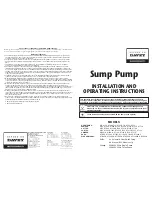
4 For Professional Technical Support call 1-844-242-2475
INSTALLATION
CAUTION:
Always use the handle to lift the pump. Never use the power cord to lift the pump. To avoid skin burns,
unplug the pump and allow time for it to cool after periods of extended use.
1. Connecting a 3/4 in. garden hose
Attach a 1 in. female adaptor (B) to the pump discharge.
Attach a garden hose with a 3/4 in. garden hose thread (not included) to the adaptor.
NOTE:
Be sure the 3/4 in. garden hose thread connector has a rubber gasket to
minimize water leaks.
NOTE:
The larger the inside diameter and the shorter the length of hose, the less
pressure that is lost (or the larger the flow rate).
2. Connecting a 1-1/4 in. hose kit
If you would prefer to use a 1-1/4 in. hose kit (not included) in order to pump water away
more quickly.
Attach the adaptor (B) to the pump (A) discharge.
Securely attach the hose kit (not included) to the adaptor (B).
WARNING:
Secure the discharge hose before plugging in the pump. An unsecured
discharge hose may “whip” possibly causing personal injury, and/or property damage.
OPERATION
1. Plugging in the pump
Place the pump on a solid base in flooded area or any place that you
would like to remove water. Plug the pump into a 115 volt GFCI power
outlet
WARNING:
Do not handle the pump or pump motor with wet hands or when
standing on a wet or damp surface, or in water.
NOTE:
Place upright on a solid base.
NOTE:
The pump must be standing in at least 1 in. (25.4 mm) of water before
you start it.
2. Operating the pump
Allow the pump to run and monitor its progress.
Unplug the pump when it has removed water down to
approximately 1/ 4in. (6.4 mm).
Remove the pump and hose from the location when finished
pumping. The hose still has water that can drain back through the
pump. Remove remaining water with a squeegee, mop, sponge,
towel, wet/dry vacuum, etc.
CAUTION:
Do not run the pump dry. Operating the pump without water will cause damage to the seals and will cause
the pump to fail, thereby voiding the pump’s warranty.





































